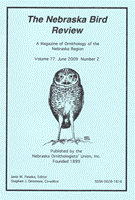Nebraska Ornithologists' Union

Nebraska Bird Review
Date of this Version
6-1988
Document Type
Article
Citation
Nebraska Bird Review (June 1988) 56(2).
Abstract
On 16 March 1988 Ron Hoffman and I observed nine Tundra Swans (Cygnus columbianus) on a sandpit lake approximately 4 miles east of the I-80 interchange at North Platte. The lake's legal description is Tl3N, R29W, SW¼ of Section 8. The Swans were reported to the Nebraska Game and Parks Commission's North Platte office at 10:30 that morning by a former resident of Nebraska's Sandhills region. He thought the Swans looked identical to Trumpeter Swans (Cygnus buccinator) he had observed while living on a ranch near Hyannis. While leading us to the lake he mentioned that the nine Swans had been using the sandpit for nearly a week, and had been feeding in a nearby picked cornfield.
Immediately upon arriving at the lake we identified the nine birds as Swans by their large size, snowy white body plumage, long necks held nearly vertically erect, and dark, broad bills held horizontally. Five of the Swans were adults, as indicated by black bills, snowy white face, head, and neck plumage, and slightly larger body size. Four of the Swans were immatures as indicated by smokey greyish-brown feathers along the back and sides of the neck and the cheek and crown areas.
All nine birds were swimming deliberately broadside to our observation point, then gradually swam away from us. We could not see the legs and feet to note coloration, but were able to notice that the immatures' bill color was not the pinkish color of younger immatures, but was the uniform gray-black color characteristic of late winter/early spring juvenile plumage (Bellrose 1980). The birds were silent throughout our observation.


Comments
Copyright 1988, Nebraska Ornithologists' Union. Used by permission.